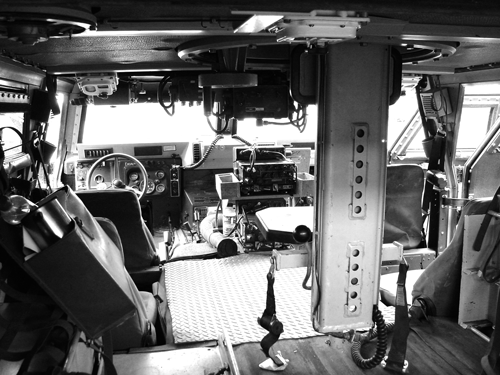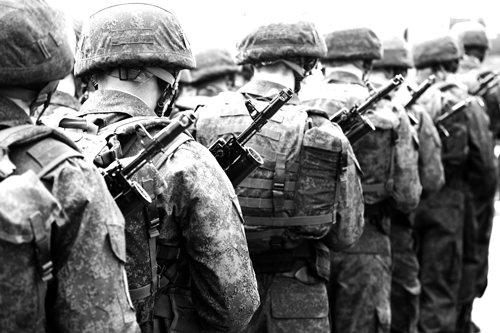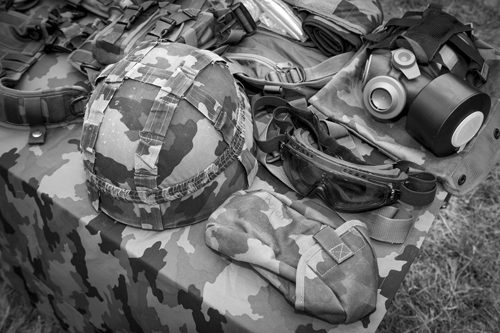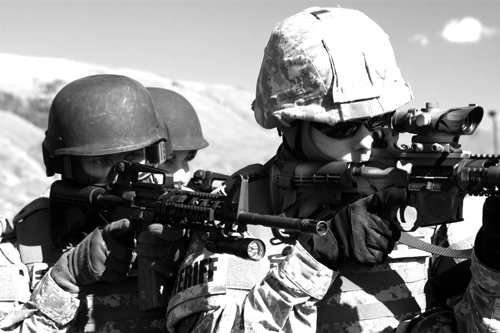Exploring the Latest Innovations in Ballistic Fabrics
As a technical textiles category, ‘ballistic fabrics’ broadly describes the types of materials that offer protection against any form of projectile impact, be it from bullets, flying debris or shrapnel. However, if we drill a little deeper and look at the different ways in which the fabrics are used, it becomes apparent that this somewhat collective term, in fact, comprises many different forms of defensive ‘armour’.

In the non-military sense, ‘blue-light’ responders such as police officers require protection from varied threats ranging from blunt force trauma, through to sharp objects and firearms.
In more conventional military applications, on the other hand, personal equipment and clothing are designed to offer protection during combat situations of even greater seriousness, whilst military vehicles and transporters – with their internal panels, seating systems and linings – can also be engineered to reduce the risk of harm to individuals within.
Protecting from threats
In each of these end-application examples, as the potential speed, force, size and frequency of the projectiles escalates – alongside the consequential risk of harm – so too does the level of personal protection required. Because of the varied nature of the hazardous environments that they are used in, ballistic fabrics are often even expected to be multi-functional, providing some form of protection from additional threats such as heat, flame and chemicals.
These secondary characteristics may already be inherent within the textiles, or they can be specifically engineered, particularly if the fabrics are used in conjunction with other materials such as hard plates, ceramics or composites. However, the diverse nature of this market, plus the varied construction of ballistic protection depending on the threat level, means the makeup of these protective materials can be very different.
Under closer scrutiny, the umbrella classification of ‘ballistic’ therefore opens out into much more complex and detailed sub-categories of technical textile manufacturing.
The history of ballistic fabrics
When reflecting on early examples of protective clothing, many people will immediately think of knights in medieval suits of armour. But, one of the earliest modern examples of soft ballistic clothing was the original heavy-weight flak jacket, issued to early C20th militaries. Once woven from nylon, the jackets were designed to be tough, long-lasting and offering at least some protection from shell fragments. However, as firearm technology has advanced – with bullets and projectiles now travelling at higher velocities with increasingly deadly force – so too have ballistic materials in an attempt to keep pace.
There have been light weighting drivers for innovation too. The original old-fashioned ballistic nylon jacket could typically weigh up to 22lb/10kg which has risen to 14-16kgs in modern versions, with the addition of extra plates and protection. This load and bulk, combined with restrictions to movement and speed and the subsequent physiological burden of heat stress and fatigue, for many, outweighs the limited protection offered in combat situations.
So how have the fabrics evolved?
Firstly, it is important to note that it is not the fabric in isolation that protects from the ballistic impact. Instead, the craft lies in the method of combining layers of fabrics alongside other materials into the necessary protective assembly.
Nevertheless, the science behind the materials has evolved over time. Advancements in synthetic yarns, for example, have seen fibres with increasingly higher strength to weight ratios come to market. The first major step-change came in the 1970s with the introduction of Kevlar, renowned for having a tensile strength far in excess of steel. It was found that arrangements of these lighter weight, high performance ‘bulletproof’ fabrics allowed for a reduction in the reliance on heavy metal or composite plates, whilst achieving the same level of projectile stoppage at only a fraction of the weight.

Thereafter, Dyneema, Zylon and Twaron artificial fibres were introduced to further enhance armour flexibility and light weighting. In the 1980s, the US military issued the PASGT Kevlar vest, before upgrading to Interceptor body armour shortly after the millennium. This more modular concept brought about the use of inserts that could offer enhanced protection to key areas of the body, including the throat, groin and bicep. Additional advancements have been made with the introduction of the Improved Outer Tactical Vest (IOTV) by the US army in 2007 which offered Deltoid and Auxiliary Protector System (DAPS), ESAPI (Enhanced Small Arms Protective Insert) and Enhanced Side Ballistic Inserts (ESBI). The IOTV is produced by a number of manufacturers including Point Blank Body Armor, BAE Systems, KDH Defense Systems and Creative Apparel Associates.
We have seen slightly different geographical variances, with the UK military adopting the Osprey kit, manufactured by CQC Ltd in Barnstaple – now in its fourth iteration – in 2006. However, in virtually every international scenario, a ‘core’ protective system concept has emerged, which can then be modified or added to depending on the circumstances of its deployment and the anticipated threats. In terms of efficiencies, this presents opportunities for standardisation and therefore greater economies of scale, if the degree of bespoke manufacture is reduced.
Listed back to back, the advancements seem significant. However, when benchmarking this sector with many other areas of technical textiles, innovation in ballistic fabrics has been comparatively much slower to progress. In recent times we have not seen any breakthroughs as significant as those in the 1970s. Instead, the industry has witnessed incremental move-ons of existing solutions, which fundamentally centre on multiple-layer iterations of fabrics, using a single fibre type.
The manufacturing process
In terms of ballistic fabric assembly, the weaving process itself relies on the manufacturer being equipped with the correct looms and the technical experience of working with these yarn types. The key is to obtain an optimum strength to weight ratio, because – very much like other non-ballistic PPE such as firefighter uniforms – there is a crucial balance to strike between wearability and survivability.
 Of course, as fibres have evolved, light-weighting has become easier, resulting in more user-friendly fabrics. Body armour packs are then constructed using multiple fabric layers which are rotated through the axis to spread force loading from impact and prevent penetration. Unidirectional laminates, felts and even coated textiles can also be used, depending on the fabric specification.
Of course, as fibres have evolved, light-weighting has become easier, resulting in more user-friendly fabrics. Body armour packs are then constructed using multiple fabric layers which are rotated through the axis to spread force loading from impact and prevent penetration. Unidirectional laminates, felts and even coated textiles can also be used, depending on the fabric specification.
The evolution of those specifications on the whole, however, has been very slow. This is, in part, because due diligence is a key area of responsibility when it comes to equipment that is potentially responsible for protecting from harm and preserving life. Therefore, the stakes are high with no excuse for error.
Contracts for the manufacturing and supply of ballistic equipment also tend to be determined in a top-down manner – not an uncommon procurement practice for public bodies and governments. However, these strict tender processes typically lock incumbent suppliers into long-term contracts and particular ways of working, until the next tender cycle presents the opportunity for review. It is therefore unsurprising that the pace of change in the market is very gradual.
Design and tailoring trends
Where we have seen some marked innovation over time, is in the design and tailoring of body armour. The rationale for these advancements stems partly back to the wearability debate, as stiff, bulky or heavy garments curtail the individual’s freedom to move easily.
Side openings have also been introduced, as have load carriage slots and areas for additional panels to better protect the upper torso, for instance, without the use of unnecessary add-ons that increase the garment’s weight. Future innovations may include the incorporation of wearable technologies including Man Worn Power and Data (MWPD), external skeletal structures to spread load-bearing stresses and, potentially, physiological sensors to monitor vital signs. In terms of component fabrics, optimising performance could be by using a hierarchical approach to body armour design – incorporating novel weaving techniques, different fibres, yarns and textile constructions and coatings to maximise the through-thickness protection, whilst reducing weight, mass and stiffness.
Tailoring has also been influenced significantly by the changing roles of women, particularly in the military.

Whilst female military personnel have long had a presence in combat zones, their role within the armed forces has changed dramatically in the past few decades. Late 1989 marked the first time a US woman had commanded soldiers in battle, during the invasion of Panama. The 1991 Gulf War was also widely-acknowledged as a pivotal time, with more than 40,000 US women serving in almost every role the armed forces needed to fill, and British women deployed in their first combat operation since 1945. Admittedly they were not permitted to participate in deliberate ground engagements but even this has changed in recent times. Defence Secretary Ash Carter stated that all combat jobs would be open to women in the US from 2016 and, similarly, last year, the then Prime Minister David Cameron lifted the ban preventing women from serving in close combat roles in the British military.
All of this demonstrates the demand for kit and equipment that – in order to be practical and effective – needs to be designed to meet the requirements of different body shapes and sizes.
The financial implications of innovation
Virtually no manufacturing process can be analysed without a mention of cost – another important factor that comes into play when advancing the light weighting and mobility of body armour without affecting performance.
Unfortunately, innovation is often a financially-intensive exercise, particularly at the testing and certification phase, and the degree of due diligence required is vast.
The testing itself is also subject to very stringent certification standards, much like the requirements for any other type of technical textiles.
In the UK, a complex framework of conditions – as set out in the Home Office Scientific Development Branch Body Armour Standards 2007* – must be observed and satisfied, depending on the garment type and the required level of protection. Each fabric must also be tested at least five times for complete assurance.
Two examples of ballistic material tests are outlined below:
| HOSDB Body Armour Standard (UK) 2007 — Ballistic | |||||
| Protection Level | Bullet Type | Bullet Weight[g] | Bullet Velocity[m/s] | Max Back Face Deformation[mm] | Test Conditions |
| HG1 | 9 mm FMJ
DM11A1B2 Dyn. Nobel |
8.0 | 365 ± 10 | 25 | Low
handgun, 0° and 45° at 5 m. |
| .357 Magnum SPFN
R357M3 Remington |
10.2 | 390 ± 10 | |||
| HG3 | 5.56mm x 45 NATO (.223) LE223T3 | 4.01 | 750 ± 10 | 25 | Carbine, 0° at 10 m. |
In the US, equally rigorous but slightly different testing requirements are imposed for protection levels I-IV, with another two examples outlined below:
| NIJ Standard (US) — 0101.04 — Ballistic | |||||
| Protection Level | Bullet Type | Bullet Weight[g] | Bullet Velocity[m/s] | Max Back Face Deformation[mm] | Test Conditions |
| I | .22 Caliber LR LRN | 2.6 | 329 ± 9 | 44 | 0°, 30° and Wet |
| .380 ACP FMJ RN | 6.2 | 322 ± 9 | 0°, 30° and Wet | ||
| IV | .30 Caliber M2 AP | 10.8 | 878 ± 9 | 44 | 0°, 30° and Wet |
| NIJ Standard (US) — 0101.04 — Ballistic | |||||
| Protection Level | Bullet Type | Bullet Weight[g] | Bullet Velocity[m/s] | Max Back Face Deformation[mm] | Test Conditions |
| I | .22 Caliber LR LRN | 2.6 | 329 ± 9 | 44 | 0°, 30° and Wet |
| .380 ACP FMJ RN | 6.2 | 322 ± 9 | 0°, 30° and Wet | ||
| IV | .30 Caliber M2 AP | 10.8 | 878 ± 9 | 44 | 0°, 30° and Wet |
Key:
AP = Armour Piercing
FMJ = Full Metal Jacket
LR LRN = Long Rifle Lead Round Nose
RN = Round Nose
The data underpinning the testing criteria is understandably very extensive, so in some respects, it is no surprise that the industry has been slow to push the boundaries.
Are financial factors the only reason for limited progress?
It could additionally be argued that the fear of product failure also prevents some manufacturers from instigating change.
For example, a renowned American body armour firm – one of the first to use Kevlar back in the 1970s – later hit the headlines for very different reasons. The company’s protective Zylon garments had been widely used in the US police force since the late 1990s, but an incident in 2003 left two officers seriously injured. It was eventually deemed that the vests had failed in use, and subsequent studies found that fibre degradation caused by moisture meant wearers were less protected than expected. Consequently, the firm recalled vests containing Zylon and the US Department of Justice eventually decertified the fibre for use in its approved models of law enforcement ballistic vests.
Should the industry be demanding more?
No industry should ever stand still, especially with technological advancements continuing apace – with innovation comes newfound abilities to do things differently, as any manufacturer will know. For such progress to arise, collaboration between industry, R&D teams, government bodies and end users, is essential. Much is taking place, even in the UK alone, but at present, it is a case of ‘watch this space’.
In the mainstream media some wider ‘breakthrough’ examples are also occasionally reported, such as the Fox News claim in June 2017 that a young air force cadet had developed a bulletproof substance by combining an anti-ballistic fabric with a shear thickening fluid. The result was a lightweight body armour material that stopped three rounds from a .44 Magnum. Will this working concept come to fruition? It is difficult to say. Shear thickening fluids have been in and out of fashion for some time, but have not resulted in change as yet.
This slow progress is partly because the practicalities of cost and complexities of the sector make such change difficult. This may, therefore, be one market where incremental improvements should be expected and welcomed rather than criticised.
*HOSDB became CAST in 2011
Previous Article Next Article




